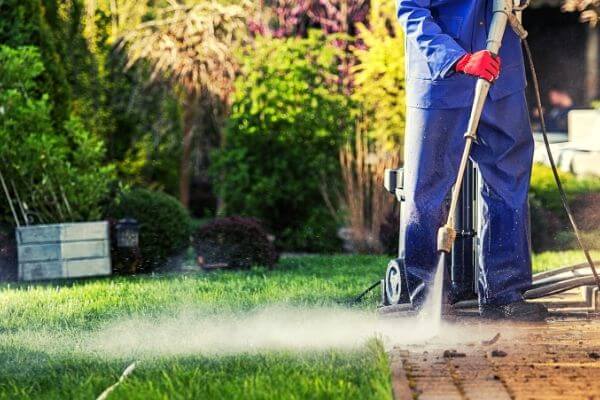
Pressure washing is a powerhouse for cleaning—but what about your plants? While it’s great at removing years of grime, dirt, and algae, many homeowners wonder:
“Can pressure washing damage my landscaping?”
The short answer: Yes, it can—but with the right technique, you can avoid the risks. ✅
Whether you’ve got a perfectly manicured garden, a patch of prized rose bushes, or even some young trees nearby, it’s important to protect your greenery while getting the job done. Let’s explore how pressure washing affects landscaping, and more importantly, how to keep your outdoor space safe and thriving. 🌼🌳💦
🚨 How Pressure Washing Can Harm Landscaping
There are three primary ways pressure washing can unintentionally damage your landscaping:
1. Physical Force
That powerful water jet can:
- Strip leaves from plants
- Snap delicate stems
- Uproot flowers or small shrubs
- Erode soil around root systems
Even at moderate PSI levels, plants simply aren’t designed to withstand that kind of impact.
2. Chemical Exposure
Many people use detergents or bleach when pressure washing surfaces like siding, decks, and concrete. But those chemicals:
- Can burn or kill plants if they come into contact with leaves or roots
- May soak into the soil, affecting long-term plant health
- Could run off into nearby garden beds without proper barriers
🚫 Even eco-friendly cleaners can be harmful in large concentrations or with direct spray.
3. Hot Water or Surfactants
Some commercial-grade pressure washers use heated water or added surfactants for more effective cleaning. While great for grime, it can be a death sentence for your begonias. 🥵
Browse Amazon Here For Popular Pressure Washers And Accessories
🌿 Tips to Protect Your Plants While Pressure Washing
If you want your landscaping to thrive after pressure washing, here’s how to make sure you don’t cause collateral damage:
✅ 1. Cover Vulnerable Plants
Use:
- Plastic sheeting or tarps
- Old bed sheets or towels (more breathable)
- Cardboard barriers or plywood for large beds
Secure covers loosely around base areas and gently over foliage. Be sure to remove them right after washing to avoid heat buildup or suffocating the plants.
✅ 2. Pre-Wet the Soil and Foliage
Spraying your plants with plain water before pressure washing helps dilute any chemicals that might land on them. It also reduces absorption through leaves and roots.
💧 Think of it as putting sunscreen on your garden.
✅ 3. Avoid Direct Spray Near Plants
Never aim your pressure washer directly at:
- Flower beds
- Shrubs
- Mulch
- Soil banks
Instead:
- Spray away from the garden
- Angle the nozzle downward so runoff flows toward pavement, not plants
- Maintain a safe buffer zone of at least 3–5 feet from landscaping
✅ 4. Use Biodegradable, Plant-Safe Detergents
Always check your detergent’s label. Look for terms like:
- “Non-toxic to plants”
- “Biodegradable”
- “Eco-safe”
Avoid bleach-based solutions unless you’re in an area with no vegetation nearby.
✅ 5. Control Your Runoff
Use tarps or landscaping edging to create water barriers. This helps:
- Keep dirty water from soaking into your flower beds
- Prevent detergent from pooling near roots
- Redirect flow to hard surfaces or drains
🧠 Pro Tip: Use a shop vac or water broom to direct excess water where you want it.
✅ 6. Rinse Plants Afterward
After you’ve finished pressure washing:
- Remove all covers
- Lightly spray your plants with clean water
- Rinse off any detergent mist or chemical residue that might have landed on them
This final rinse can make all the difference in protecting sensitive foliage. 🌿💦
🌱 Plants Most at Risk
Some greenery is tougher than others. These are particularly vulnerable to damage:
- Annual flowers (pansies, petunias, etc.)
- Delicate herbs (like basil and cilantro)
- Seedlings or freshly planted beds
- Tropical plants with large, sensitive leaves (like ferns or caladium)
- Succulents prone to root rot if overwatered
Consider temporarily relocating potted plants to a safer location before you start spraying.
🧠 Final Thoughts
Yes, pressure washing can harm your landscaping—but it doesn’t have to. With a little prep and care, you can keep your plants thriving while still enjoying a spotless patio, fence, or siding. 🌼✅
To recap:
- 🛡️ Cover nearby plants before you start
- 💦 Pre-wet soil and rinse afterward
- 🧴 Use plant-safe cleaners only
- 🚫 Never spray directly at gardens or mulch
- 🚧 Watch for runoff and chemical drift
A little mindfulness goes a long way. Clean your property without sacrificing the green life that makes it beautiful. 🌺🧼🌞
Browse Amazon Here For Popular Pressure Washers And Accessories






